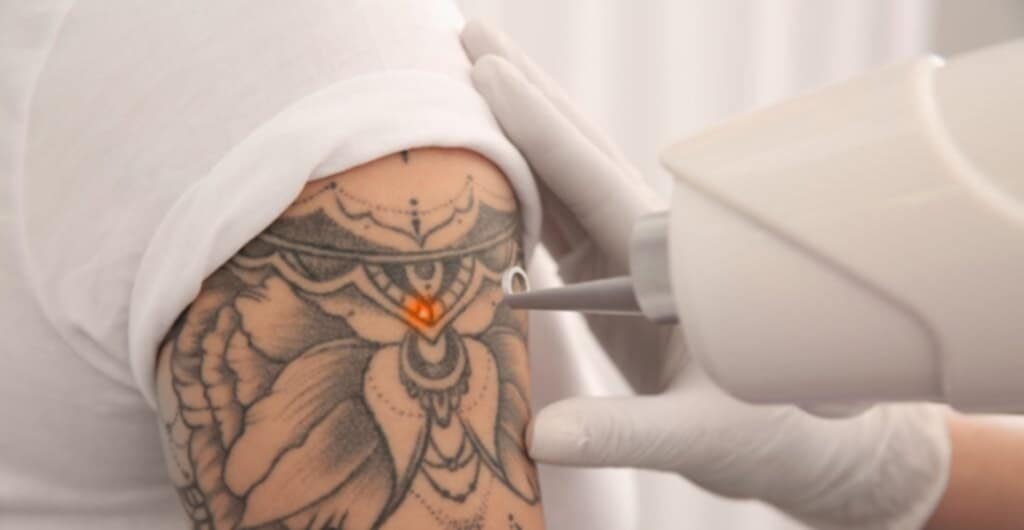TATTOO REMOVAL
It takes more than one session to remove a tattoo, because when you got your tattoo, your tattoo artist applied the ink in layers. Lasers break the ink pigment into smaller particles, it then takes some time between sessions for your body to flush out the ink. Your skin also needs time to heal. Tattoo removal pain is comparable to the pain of a bad sunburn, and the laser pulses feel like a rubber band snapping against your skin. Most people find that there’s little to no scarring from the process. More frequently occurring in those with darker skin tones, scarring can come about due to a loss of pigmentation.
Very small ( up to 3 cm ) 20min / £45
Small ( up to 5cm ) 25 min / £65
Medium ( up to 8 cm ) 30 mins / £85
Large ( up to 10 cm ) 40 mins / £125
Very large ( up to 15 cm ) 45min / £135

Laser tattoo removal works by using concentrated light energy to break down the ink particles in a tattoo, allowing the body’s immune system to gradually remove them. Here’s a breakdown of the process:
How Laser Tattoo Removal Works:
- Targeting the Ink:
- A laser device emits short, high-intensity pulses of light that penetrate the skin and target the pigment in the tattoo. Different laser wavelengths are used depending on the ink color, as different pigments absorb light at different wavelengths.
- For example, Q-switched lasers and picosecond lasers are commonly used. These lasers deliver very short bursts of energy that are powerful enough to break down the ink particles without damaging surrounding skin.
- Breaking Down Ink Particles:
- The intense light energy from the laser heats up and shatters the ink particles into tiny fragments.
- Over multiple sessions, the laser continues breaking down the ink until it’s fine enough for the body to remove naturally.
- Body’s Natural Removal Process:
- After the ink particles are broken down, the body’s immune system gradually absorbs and removes them from the treated area through lymphatic drainage.
- Because this process takes time, tattoo fading happens gradually, typically requiring several weeks between sessions for best results.
Factors Affecting Laser Tattoo Removal:
- Tattoo Ink Color: Dark inks like black and blue absorb laser light more easily and respond better to removal than lighter colors like yellow or green, which may require specific wavelengths.
- Tattoo Depth and Age: Older and shallower tattoos are generally easier to remove, as some ink has naturally faded over time.
- Skin Type: Skin tone can influence the removal process. Darker skin may require more careful laser settings to avoid affecting surrounding skin pigmentation.
Sessions and Results:
- Number of Sessions: Most tattoos require multiple sessions (often 6-10 or more), spaced 4-8 weeks apart.
- Visible Fading Over Time: Each session breaks down more of the ink particles, leading to gradual fading until the tattoo is no longer visible.
Potential Side Effects:
- Temporary Skin Reactions: Redness, swelling, and blistering are common after laser tattoo removal but typically heal within a week.
- Pigment Changes: Some people may experience temporary lightening or darkening of the skin in the treated area.
With the right laser type, proper care, and patience, laser tattoo removal is an effective way to significantly fade or remove unwanted tattoos.
